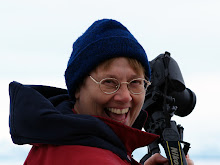 Complementary Blends 2 - Blue and Orange
Complementary Blends 2 - Blue and Orange.
Colored pencil on paper, 6.5" x 10"
.
Hue, saturation and value are different ways of looking at colors. With complementary pairs, there are only two hues, just two colors, in this case orange and blue.
Saturation, or color intensity, is a way of noticing how brilliant or dull a color looks. As complementary color blends approach a neutral tone, they become lower and lower in intensity.
Value is a way of describing how light or dark a color appears.
The two
hues in this drawing are blue and orange. I used a single blue pencil as close in pigment to a spectrum blue as I could find in my 120-pencil universe, and a single orange pencil, also as close in pigment to a spectrum orange as possible.
The colors in this complementary pair are at their highest
saturation. They are as intense as the pigment will allow. When I blended the orange and blue to make different tones of browns, the saturation got less and less as the color got closer to a pure brown and away from the bluish tones or the orangey tones.
The
value, or the lightness, of the orange is higher than the value of the blue. In other words, the blue is darker than the orange. As the blue and orange are blended, the value of the resulting brown also blended. The orangey-browns are higher in value than the bluish-browns.
Knowing how to use the intensity of the color to create contrast or emphasis in a drawing, and knowing how to manipulate the lightness and darkness for atmospheric or emotional effect are useful tools for artists.
.
.















